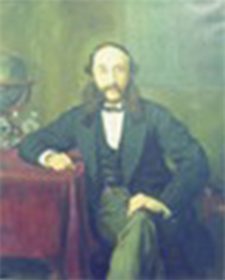Samuel Levi Phillips Of Haverfordwest
Founder of the Haverfordwest Bank

When researching our Watkins/Baker family line, we were intrigued to discover that our fifth great-grandfather was a German-born jeweller and banker named Samuel Levi from Haverfordwest. Samuel’s connection to our Watkins line is through his daughter, Catherine Levi, who married Samuel Baker in 1790. Their son, William Baker, had a daughter named Ann, who married our 2nd great-grandfather, William Watkins, in 1854.
Samuel Levi was born in Frankfurt, Germany, to parents Alexander and Erol. He travelled to England with his brother Moses and acquired property in Lambeth, London. Sensing opportunities in Wales, the brothers initially settled in Swansea before moving to the bustling port of Haverfordwest in Pembrokeshire.
It is believed that the Levi brothers relocated to Pembrokeshire around 1750. Some sources suggest that they may have been familiar with another Jewish migrant, Benjamin Gabriel, who was already residing in Haverfordwest. Upon arrival in Pembrokeshire, the brothers were befriended by a local gentleman named Phillips. In recognition of his kindness, both men adopted his name, and Samuel became known as Samuel Levi Phillips. In 1753, Samuel married Dorothy Hood from Babylon in Pembrokeshire at the age of 23. The wedding took place on November 11th at St Mary’s Church in Haverfordwest.
Just weeks before the marriage, Samuel converted from Judaism to Christianity and was baptised at St Mary’s Church in Haverfordwest. The ceremony was performed by Rev. Hugh Bowen. It is thought that Samuel converted to better assimilate with the local community. The following year, his brother Moses also converted to Christianity.


Samuel and Dorothy set up home in Haverfordwest, where Samuel worked as a jeweller and silversmith. He found much success and built considerable wealth. The couple had six children together: Elizabeth (1754), Phillip (1756), Sarah (1757), Dorothy (1758), Nathaniel (1761), and John (1762). Tragically, Dorothy died just a few months after giving birth to John, leaving Samuel to raise their children alone.
On May 1st, 1763, Samuel remarried at St Mary’s Church. His second wife was Mary Jones, the daughter of Stephen Jones of Prendergast, Pembrokeshire. The couple had three more children: Catherine (1766), George (1767), and Lucy (1769). Samuel worked hard and earned a prominent place in local society. This was demonstrated by his signing a Loyal Address to King George III from the borough of Haverfordwest on October 18th, 1775, pledging their loyalty during the troubles with the rebellious American colonies.
Samuel was involved in the buying and selling of precious metal goods, rings, bracelets, and necklaces. He also provided cash advances against items and charged interest on pawned goods. These transactions led to Samuel’s most notable achievement: the establishment of Pembrokeshire’s first bank in Haverfordwest in 1783. With their success the Phillips family lived at Slebach Hall, a Grade II listed 18th century estate.
The Haverfordwest of the 1790s and early 1800s was a town of considerable charm and gentility, with Georgian architecture, cobbled streets, and handsome merchant warehouses fronting Quay Street and Bridge Street. The whitewashed cottages and hanging gardens struck visitors, while the bustling port and genteel society fostered an affluent professional class of wealthy merchants, doctors, lawyers, and clergy. This environment enabled the Haverfordwest Bank to prosper despite the political uncertainty of the 1790s and food rioting in 1795.


Samuel’s second wife, Mary, died in 1806, and he followed six years later in 1812. Samuel is buried in St Thomas’s Church, Haverfordwest. The extent of his wealth is shown in his will, dated July 3rd, 1811, in which he bequeathed his property to close family members. His son Philip received a property in Prendergast named the Barley Mow, plus three more houses and property in the new town of Milford, as well as £1,000 invested in the capital of the Milford and Pembrokeshire Bank.
Samuel Levi Phillips bequeathed to his son John six houses in St Thomas’ parish, plus £100, while Stephen received a leasehold house in Lambeth, Surrey, £100, and £600 due on a promissory note. Nathaniel Phillips was to receive the residue of the estate, while Samuel’s daughters were to receive £1,000 each, and the grandchildren £100 each. Samuel was buried in St Thomas’ churchyard, and Nathaniel succeeded his father as the sole manager of the Haverfordwest Bank.
Unfortunately, Nathaniel’s management of the bank ended in disaster. The precise circumstances that led to a run on the bank and subsequent collapse are complicated. Correspondence from the time suggests that mistakes made by Thomas Phillips, Nathaniel’s brother in law, played a large part, as did political disagreements in West Wales. The London Gazette published the bankruptcy of Nathaniel on January 31st, 1826. The effects of this failure were felt immediately in the local area. The men of the Pembroke Dockyard received the bank’s notes as their wages, with some £700 being disbursed each week. The Collector of Customs stated at a public meeting that he circulated £50,000 in the bank’s notes annually.
As the sole proprietor, Nathaniel Phillips was entirely liable for the bank’s debts, meaning that all his personal property and assets were liable to be liquidated to meet his obligations. Nathaniel found himself without means, although not without sympathizers, and he died shortly afterward. The £1 notes issued by the Haverfordwest Bank bear his personal signature and are a fascinating piece of commercial and social history. They were symbols of the power and prestige that this migrant’s son once possessed.

